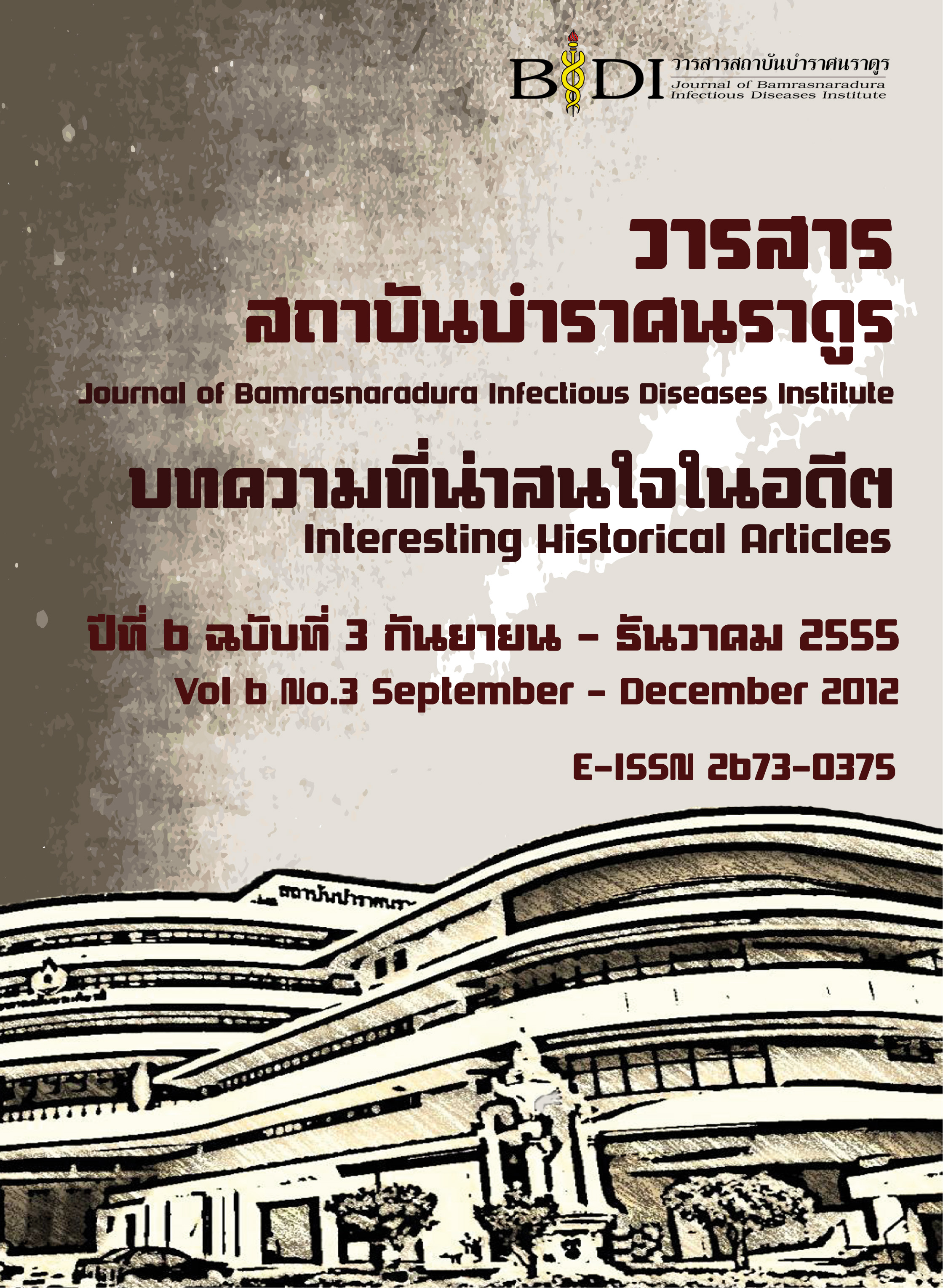การตั้งครรภ์และการมีบุตรของสตรีที่ติดเชื้อเอชไอวี/เอดส์ สถาบันบำราศนราดูร
Main Article Content
บทคัดย่อ
การศึกษาครั้งนี้มีวัตถุประสงค์เพื่อศึกษาสถานการณ์การตั้งครรภ์และการมีบุตรของสตรีที่ติดเชื้อเอชไอวี/เอดส์ในสถาบันบำราศนราดูร โดยเก็บรวบรวมข้อมูลโดยการสัมภาษณ์ และตอบแบบสอบถามสตรีติดเชื้อเอชไอวีที่อยู่ในวัยเจริญพันธ์ทุกราย อายุระหว่าง 15-49 ปี ที่มาตรวจคลินิกสูตินรีเวช สถาบันบำราศนราดูรช่วงระหว่างเดือนตุลาคม 2553-ธันวาคม 2553 ผลการศึกษาพบว่า ไม่ตั้งครรภ์แต่เคยตั้งครรภ์มาก่อนร้อยละ 72.4 ไม่ตั้งครรภ์และไม่เคยตั้งครรภ์มาก่อนร้อยละ 18.7 และกำลังตั้งครรภ์ร้อยละ 8.9 ตามลำดับ โดยเป็นการตั้งครรภ์โดยไม่ตั้งใจสูงถึงร้อยละ 72.4 ส่วนใหญ่เคยมีบุตรแล้วร้อยละ 70.3 แต่เป็นการมีบุตรกับคู่สมรสปัจจุบันเพียงร้อยละ 44.6 และมีความต้องการมีบุตรร้อยละ 27.4 จากสถานการณ์ดังกล่าวพบว่าสตรีติดเชื้อเอชไอวีมีความจำเป็นที่จะต้องได้รับความรู้ความเข้าใจเรื่องการวางแผนครอบครัวและการคุมกำเนิด ดังนั้นการสนับสนุนและพัฒนาระบบการวางแผนครอบครัว คลินิกวางแผนครอบครัว ตลอดจนการให้ความรู้เรื่องการวางแผนครอบครัวเป็นสิ่งที่จำเป็นสำหรับสตรีติดเชื้อเอชไอวีและคู่ของสตรีติดเชื้อเอชไอวีทุกราย เพื่อให้สามารถวางแผนครอบครัวให้ได้ถูกต้องและดียิ่งขึ้น
Article Details
เอกสารอ้างอิง
2. Rochat TJ, Richter LM, Doll HA, Buthelezi NP, Tomkins A, Stein A. Depression among pregnant rural South African women undergoing HIV testing. J Am Med Assoc 2006; 295(12): 1376-8.
3. Nakayiwa S, Abang B, Packel L, Lifshay J, Purcell DW, King R, Ezati E, Mermin J, Coutinho A, Bunnell R. Desire for children and pregnancy risk behavior among HIV-infected men and women in Uganda. AIDS and Behavior 2006; (10 Suppl 4): S95-104.
4. Chen JL, Philips KA, Kanouse DE, Collins RL, Miu A. Fertility desires and intention of HIV-positive men and women. Fam Plann Perspect 2001; 33: 144-52.
5. Ogilvie G, Palepu A, Remple VP, et al. Fertility intentions of women of reproductive age living with HIV British Columbia, Canada. AIDS 2007; 21: S83-88.
6. Finer LB, Henshaw SK. Disparities in rates of unintended pregnancy in the United States 1994 and 2001. Perspect Sex Reprod Health 2006; 38: 90-6.
7. AIDSThai. วิเคราะห์สถานการณ์โรคเอดส์ในประเทศไทย พ.ศ. 2553. นนทบุรี: สำนักโรคเอดส์ วัณโรค และโรคติดต่อทางเพศสัมพันธ์ กรมควบคุมโรค; 2553.
8. สำนักที่ปรึกษา. แนวทางการดำเนินโครงการพัฒนารูปแบบการให้บริการอนามัยเจริญพันธ์สำหรับผู้ติดเชื้อเอชไอวี. นนทบุรี: กรมอนามัย; 2551.
9. Allen S, Meinzen-derr J, Kautzman M, Zulu I, Trask S, Fideli U, et al. Sexual behavior of HIV discordant couples after HIV counseling and testing. AIDS 2003; 17: 733-40.
10. De Bruyn M, Njoko M, Odhiambo D, Paxton S. HIV/AIDS, pregnancy and abortion-related care: A preliminary inquiry. Chapel Hill: Ipas; 2002.
11. Nebie Y, Meda N, Leroy V, Mandelbrot L, Yaro S, Sombie I, et al. Sexual and reproductive life of women informed of their HIV seropositivity: A prospective cohort study in Burkina Faso. J Acquired Immune Defic Syndr 2001; 28: 367-72.
12. Saada M, Le Chenadec J, Berrebi A, Bongain A, Delfraissy JF, Mayaux MJ, et al. Pregnancy and progression to AIDS: Results of the French prospective cohorts. SEROGEST and SEROCO Study Groups. AIDS 2000; 14: 2355-60.
13. De Vincenzi I, Jadand C, Couturier E, Brunet JB, Gallais H, Gastaut JA, et al. Pregnancy and contraception in a French cohort of HIV-infected women. SEROCO Study Group. AIDS 1997; 11: 333-8.
14. Desgrees Du Lou A, Msellati P, Viho I, Yao A, Yapi D, Kassi P, et al. Contraceptive use, protected sexual intercourse and incidence of pregnancies among African HIV-infected women. DITRAME ANRS 049 Project, Abidjan 1995-2000. Int J STD AIDS 2002; 13: 462-46.
15. Hankins C, Tran T, Lapointe N. Sexual behavior and pregnancy outcome in HIV-infected women. Canadian Women’s HIV Study Group. J Acquired Immune Defic Syndr Hum Retrovirol 1998; 18: 479-87.
16. Mitchell HS, Stephens E. Contraceptionchoice for HIV positive women. Sex Transm Infect 2004; 80: 167-73.
17. Murphy D, Lynch M, Desmond N, Mulcahy FM. Contraceptive practices in HIV seropositive females in Ireland. Int J STD AIDS 1993; 4: 107-9.
18. Wilson TE, Massad LS, Riester KA, Barkan S, Richardson J, Young M, et al. Sexual, contraceptive, and drug use behaviors of women with HIV and those at high risk for infection: Results from the Women’s Interagency HIV Study. AIDS 1999; 13: 591-8.
19. Sarna A, Luchters S, Munyao P, Okal J, Shi kely K, Mandaliya K, et al. Fertility preferences and family planning experiences among ART clients in Mombasa, Kenya. Proceedings of the International Conference on Actions to Strengthen Linkages between Sexual and Reproductive Health and HIV/AIDS; 2007. P. 4-7.
20. Barroso PF, Schechter M, Cerbino-Neto J, Almeida MH, Littleton M, Harrison LH. Sexual activity after initiation of antiretroviral therapy in Brazil. Proceedings of the XIV International AIDS Conference, Barcelona, Spain; 2002. P. 7-12.
21. Aaron EZ, Criniti SM. Preconception Health Care for HIV-infected Women 2007; 15(4):137-41.
22. Uganda Bureau of Statistics. Uganda Demo graphic and Health Survey preliminary report. Kampala, Uganda and Calverton, Maryland, Uganda Bureau of Statistics and ORC Macro; 2006.
23. Westoff CR. New estimates of unmet need and the demand for family planning. Calverton, Maryland, Macro International Inc., DHS Comparative Reports No 14; 2006. p. 83.
24. Padian NS, Shiboski SC, Glass SO, Vittinghoff E. Heterosexual transmission of human immunodeficiency virus (HIV) in northern California: Results from a ten-year study. Am J Epidemiol 1997; 146: 350-7.
25. Stanwood NL, Cohn SE, Heiser JR, Pugliese M. Contraception and fertility plans in a cohort of HIV-positive women in care. Contraception 2007; 75: 294-98.


